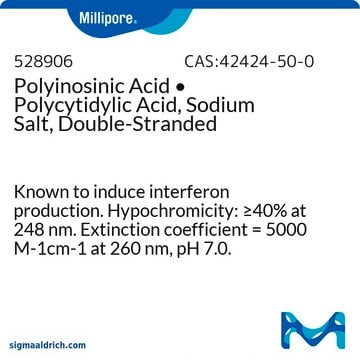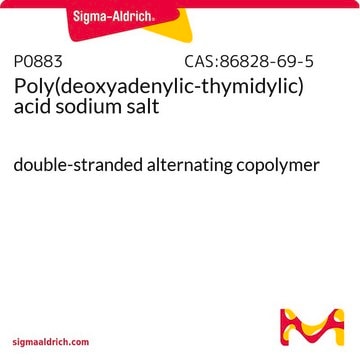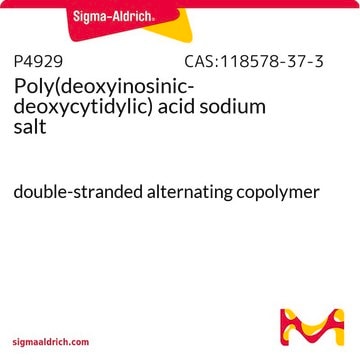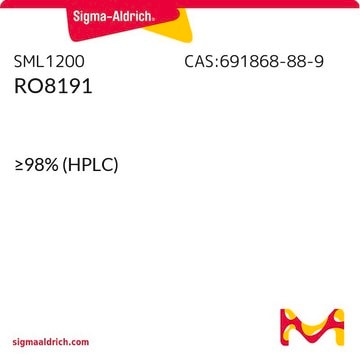The long term stability of this product in solution is not been investigated. However, aqueous solutions are expected to be stable for at least 6 months when stored in working aliquots at -20°C. Please see the link below to review the product datasheet for additional information:
https://www.sigmaaldrich.com/deepweb/assets/sigmaaldrich/product/documents/143/182/p9582pis.pdf
P9582
Polyinosinic–polycytidylic acid potassium salt
with buffer salts, TLR ligand tested
Synonym(s):
Poly (I:C), Poly(I) • Poly(C)
Select a Size
About This Item
Recommended Products
Quality Level
Assay
≥99% (less than 1% free nucleotides, TLC)
form
lyophilized powder
composition
Poly(I) • Poly(C), 10% (balance buffer salts as sodium chloride and sodium phosphate)
storage condition
desiccated
storage temp.
−20°C
Looking for similar products? Visit Product Comparison Guide
Application
Biochem/physiol Actions
Packaging
Other Notes
Preparation Note
Storage Class Code
11 - Combustible Solids
WGK
WGK 3
Flash Point(F)
Not applicable
Flash Point(C)
Not applicable
Personal Protective Equipment
Choose from one of the most recent versions:
Certificates of Analysis (COA)
Don't see the Right Version?
If you require a particular version, you can look up a specific certificate by the Lot or Batch number.
Already Own This Product?
Find documentation for the products that you have recently purchased in the Document Library.
Customers Also Viewed
-
What is the stability of this product in solution? For example, how long would a 5 mg/mL solution last when stored at -20 celcius?
1 answer-
Helpful?
-
-
What is the size (bp) of this product?
1 answer-
This product has a estimated size range of 272 - 4242 bases with a resulting molecular weight range of 90,000 - 1,400,000 daltons.
Helpful?
-
-
Does the product P9582-5MG contain 5mg of polyI:C or 500ug (10%) of poly I:C and 4.9mg buffer salts?
1 answer-
This product contains 10% Poly (I:C) with sodium chloride and sodium phosphate buffer salts. Please see the link below to a sample Certificate of Analysis for further details regarding concentration of the Poly (I:C).
https://www.sigmaaldrich.com/certificates/sapfs/PROD/sap/certificate_pdfs/COFA/Q14/P9582-50MG0000213739.pdfHelpful?
-
-
What is the difference between Polyinosinic-polycytidylic acid potassium salt Products P9582, P1038, P1530 and P0913?
1 answer-
Prod No. P9582 as well as Prod. Nos. P1530 and P0913 are double-stranded with one strand of Poly(I) and one strand of Poly(C). Prod. No. P1038 is a single-stranded RNA analog with C and I randomly making up the polynucelotide strand. Double-stranded Prod. No. P9582 is a potassium salt while double-stranded Prod. Nos. P0913 and P1038 are sodium salts. Prod. No. P0913 is gamma-irradiated. None of the other products have been gamma-irradiated. Unlike the other products, only approximately 10% of the total mass of Prod. No. P9582 is actually polynucleotide. The remaining 90% is buffer salts as sodium chloride and sodium phosphate.
Helpful?
-
-
How stable is Product P9582, Polyinosinic-polycytidylic acid potassium salt, in solution?
1 answer-
RNA and synthetic RNA analogues will be very stable in aqueous solution as long as the solutions are not contaminated with RNase.
Helpful?
-
-
What is the molecular weight of Product P9582, Polyinosinic-polycytidylic acid potassium salt?
1 answer-
The molecular weight may vary from lot to lot with a range from 90,000 to 1,400,000 with an average of 200,000 to 500,000.
Helpful?
-
-
What is the Department of Transportation shipping information for this product?
1 answer-
Transportation information can be found in Section 14 of the product's (M)SDS.To access the shipping information for this material, use the link on the product detail page for the product.
Helpful?
-
-
Why is the total mass of Product P9582, Polyinosinic-polycytidylic acid potassium salt, in my bottle much greater than the designated package size?
1 answer-
The package size is based on the polynucleotide content. However, since the polynucleotide is supplied with sodium chloride and sodium phosphate buffer salts, its mass represented by the package size is approximately 10% of the total mass present in the bottle.
Helpful?
-
-
Should Polyinosinic-polycytidylic acid potassium salt Product P9582 or P1038 be used for cell activation?
1 answer-
For cell activation, synthetic double-stranded RNA is widely used as ligand of Toll-like receptor 3 (TLR3) in place of what is supposed to be the natural ligand (viral dsRNA). The double stranded RNA homopolymer, i.e. Poly(I):Poly(C), Prod. No. P9582 can be used for this application. P1038 is a single-stranded RNA and will not activate TLR3.
Helpful?
-
Active Filters
Our team of scientists has experience in all areas of research including Life Science, Material Science, Chemical Synthesis, Chromatography, Analytical and many others.
Contact Technical Service










